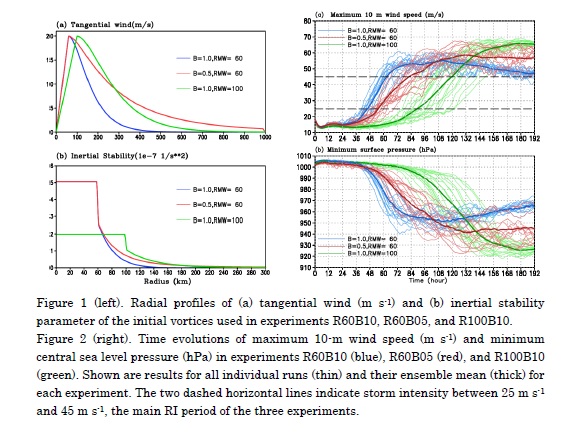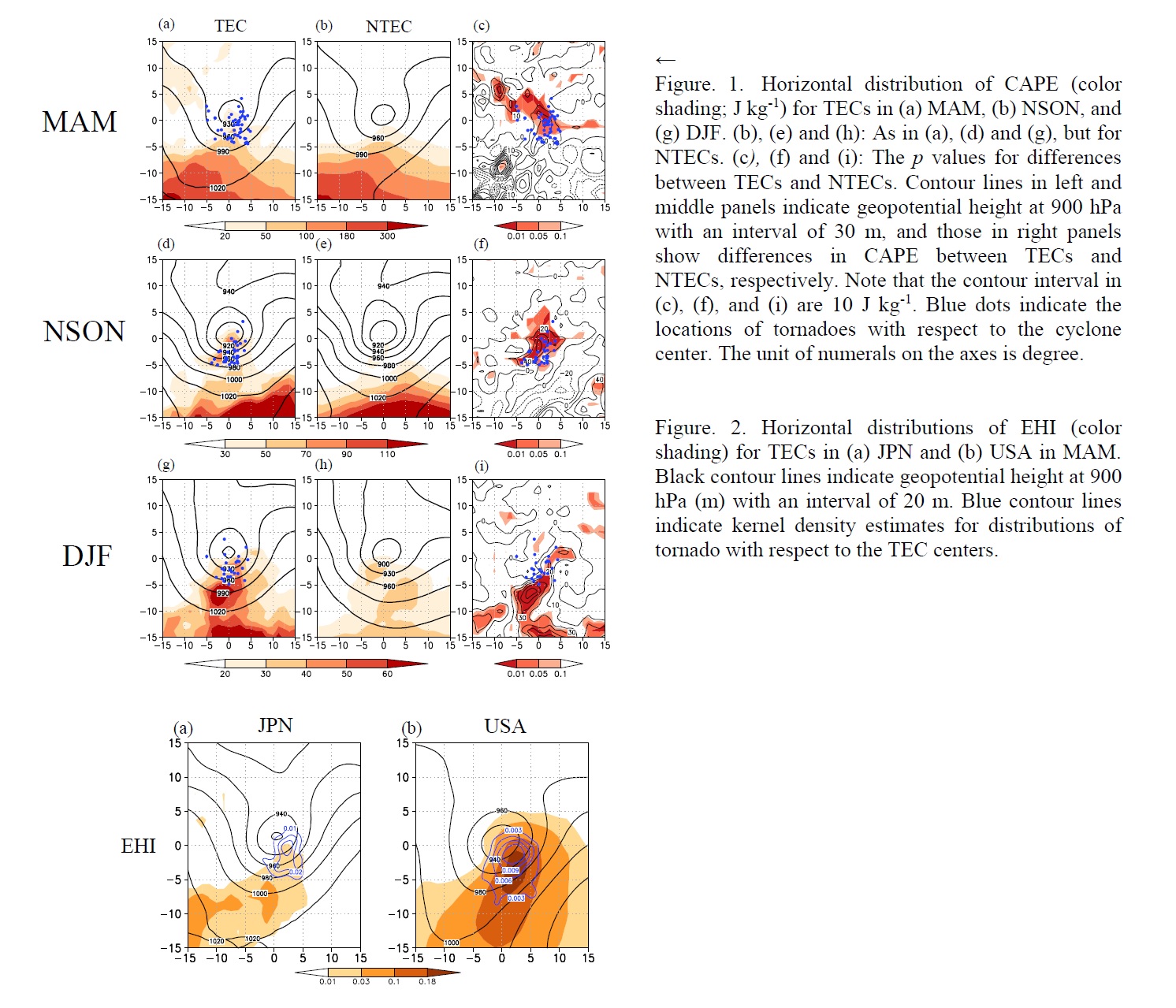JMSJ Awards
JMSJ Awards in 2018
In 2018, the following paper was awarded. JMSJ Award 2018
Xu and Wang (2018)
Xu, J., and Y. Wang, 2018: Effect of the initial vortex structure on intensification of a numerically simulated tropical cyclone. J. Meteor. Soc. Japan, 96, 111-126.
https://doi.org/10.2151/jmsj.2018-014
Graphical Abstract
Highlights:
- the initial spinup period is shorter and the subsequent IR is larger for the storm with the initially smaller RMW or with the initially more rapid radial decay of tangential wind outside the RMW;
- the longevity of the initial spinup period is determined by how quickly the inner-core region becomes nearly saturated in the middle and lower troposphere and thus deep convection near the RMW is initiated and organized. Because of the larger volume and weaker Ekman pumping, the inner-core of the initially larger vortex takes longer time to become saturated and thus experiences a longer initial spinup period;
- the vortex initially with the larger RMW (with the slower radial decay of tangential wind outside the RMW) has lower inertial stability inside the RMW (higher inertial stability outside the RMW) develops more active convection in the outer-core region and weaker boundary-layer inflow in the inner-core region and thus experiences lower IR during the primary intensification stage.
The effect of the initial vortex structure, including the radius of maximum wind (RMW) and the radial decay rate of tangential wind outside the RMW, on the intensification rate (IR) of a tropical cyclone (TC) is studied based on ensemble of simulations using a nonhydrostatic axisymmetric cloud-resolving model. The results show that:
Tochimoto and Niino (2018)
Tochimoto, E., and H. Niino, 2018: Structure and environment of tornado-spawning extratropical cyclones around Japan. J. Meteor. Soc. Japan, 96, 355-380.
https://doi.org/10.2151/jmsj.2018-043
Graphical Abstract
Highlights:
- This study used the JRA-55 reanalysis dataset to analyze the structure and environment of extratropical cyclones (ECs) that spawned tornadoes (tornadic ECs: TECs) between 1961 and 2011 in Japan.
- Our comparison of the structures and environmental parameters of TECs and non-tornadic ECs (NTECs) in each season indicates that CAPE for TECs in all seasons is larger than that for NTECs. Thus, thermodynamically more unstable environments seem to be important for tornado occurrences.
- A comparison of TECs between Japan and the United States (US) shows that SREH and CAPE are noticeably larger in the US. It is suggested that these differences occur because TECs in the US (Japan) develop over land (ocean), which exerts more (less) surface friction and diurnal heating.
Iwai et al. (2018)
Iwai, H., S. Ishii, S. Kawamura, E. Sato, and K. Kusunoki, 2018: Case study on convection initiation associated with an isolated convective storm developed over flat terrain during TOMACS. J. Meteor. Soc. Japan, 96A, 3-23.
https://doi.org/10.2151/jmsj.2017-014
Graphical Abstract
Highlights:
- Many isolated convective storms developed in the southern Kanto Plain on August 17, 2012. We clarify the dynamics leading to the convection initiation of one of them using different remote sensing instruments.
- A convergence line in the form of a sea breeze front moved inland from Tokyo Bay. A near-surface air parcel was lifted to its lifting condensation level (LCL) by an updraft in a convergence zone with a 3 km horizontal scale, which formed the west edge of the convergence line (Fig. 1).
- The saturated air parcel at the LCL was then lifted to its level of free convection (LFC; Fig. 2) by the updrafts associated with thermals below the cumulus cloud base.









